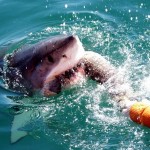 MIAMI (USA)- 2012 has seen more unprovoked shark attacks worldwide than the year before. In general, the number of shark attacks has grown at a steady pace since 1900, with each decade having more attacks than the previous.
MIAMI (USA)- 2012 has seen more unprovoked shark attacks worldwide than the year before. In general, the number of shark attacks has grown at a steady pace since 1900, with each decade having more attacks than the previous.
The International Shark Attack File (ISAF), the world’s most recognized source on shark attacks, made their annual announcement this week.
Unprovoked attacks
ISAF, part of the University of Florida, investigated 118 alleged incidents of shark-human interaction in 2012. 80 of these incidents represented confirmed cases of unprovoked shark attack on humans.
The 38 other incidents 16 provoked attacks, eight shark-boat interactions, five incidents regarded as not involving a shark, one ‘air-sea disaster’, three scavenge-incidents involving post-mortem bites, and five cases in which available evidence was insufficient to determine if an unprovoked shark attack occurred.
Higher than 2011
The 2012 yearly total of 80 unprovoked attacks was slightly higher than the 78 unprovoked attacks recorded in 2011 but on-par with the 2010 total of 82. Seven people died from shark attacks.
“The numerical growth in shark interactions does not necessarily mean that there is an increase in the rate of shark attacks”, says George H. Burgess, curator of the ISAF. “Rather, it most likely reflects the ever-increasing amount of time spent in the sea by humans, which increases the opportunities for interaction between the two affected parties.”
Recreation
The number of shark-human interactions occurring in a given year is directly correlated with the amount of time humans spend in the sea, according to Burgess. “As world population continues its upsurge and interest in aquatic recreation concurrently rises, we realistically should expect increases in the number of shark attacks and other aquatic recreation-related injuries.”
American waters
Following long-term trends, North American waters had the most (52.5%: 42 attacks) unprovoked bites in 2012. The total of 53 attacks in the United States (including 11 in non-North American Hawaii and Puerto Rico) was the highest U.S. yearly total since 53 attacks were recorded in 2000. The 2012 total lies in stark contrast with the 31 recorded in 2011, the lowest U.S. total since 2009 (29).
As has been the norm for decades, Florida again had most (49%) of the unprovoked attacks in the United States. The total of 26 Florida bites was similar to the 2001-2010 decade’s yearly average of 23. Additional U.S. attacks were recorded in Hawaii (10), California (5), South Carolina (5), North Carolina (2), and Georgia, Massachusetts, New York, Oregon and Puerto Rico (one each). Within Florida, Brevard (8) and Volusia (7) counties had the most incidents.
Hawaii’s ten attacks were its highest total since seven in 2007 and higher than its ten-year annual average of four, with most incidents occurring on Maui (5) and Kauai (3).
Worldwide
Elsewhere, attacks occurred in Australia (14), South Africa (4), and Reunion (3), with single incidents reported from The Canary Islands, Indonesia, New Zealand, Nigeria, Saudi Arabia, and Tonga.
Australia
Australia’s 14 attacks compares favorably with its average of 12 attacks per year over the past ten years (2002-2011) and the two fatalities also were in line with its 1.4 yearly average over the same time period.
Burgess: “As is often the case in situations where high-profile incidents or controversies occur – in this instance in Western Australia where five shark attacks and an ill-founded sanctioned culling hunt for endangered white sharks ensued – the bottom line is often lost in the resultant media “feeding frenzy,” viz. that Australia had a pretty average year for shark bites.”
Five attacks also occurred in New South Wales and single incidents were recorded in Queensland, South Australia, Tasmania and Victoria.
South Africa
South Africa, which also has had its share of headline years in the recent past, also had a relatively average contact year, its four attacks equal to its past ten-year average of four attacks. However, its three fatalities were higher than its recent yearly average of 1.0 per year.
To put those totals in context, within the past ten years South Africa has had years with as many as eight attacks (2010) and four fatalities (2009) but also a year (2006) having no attacks whatsoever, again underscoring the volatile nature of the phenomenon both regionally and internationally.
Reunion’s three 2012 attacks, when piggybacked with four attacks in 2011 – collectively resulting in three mortalities – suggests that this small island state has developed a problematic situation where some changes, likely anthropogenic in origin, have contributed to a higher-than-usual number of highly deleterious shark-human interactions.
Fatalities
Seven fatalities resulted from unprovoked attacks in 2012, down from the 2011 total of 13 but above the 2001-2010 yearly average of 4.4. Fatalities were recorded in South Africa (3), Australia (2), California (1) and Reunion (1).
The annual fatality rate of 8.8% was less than the 1990’s average of 12.5%, but slightly higher than the 7.4% average of the first decade of this century. The fatality rate in the U.S. was notably lower (1.9%) than that of rest of the world (22.2%), likely reflective of the greater safety and medical capacity in areas of the U.S. where shark attacks historically occur.
Surfers and others participating in board sports (60% of cases: 48 incidents) were most often involved in these incidents in 2012. Less affected recreational user groups included swimmers/waders (22%) and divers (8%).
Read more on the results of the International Shark Attack File
